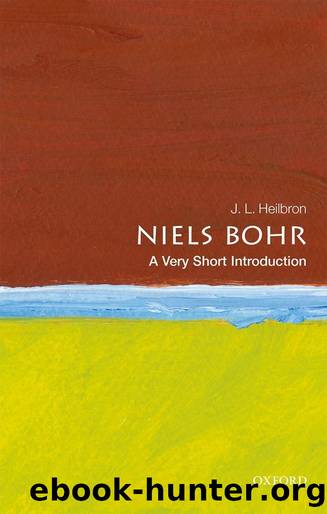Niels Bohr: A Very Short Introduction by J. L. Heilbron

Author:J. L. Heilbron [Heilbron, J. L.]
Language: eng
Format: epub
ISBN: 9780192551344
Google: unLKDwAAQBAJ
Amazon: B0822W2R2X
Publisher: OUP Oxford
Published: 2020-01-23T00:00:00+00:00
Exclusion and energy
Pauli experienced the shock of his life in Copenhagen: he took up a problem he could not solve. The problem centred on the complicated version of the Zeeman effect suffered by spectral lines in a weak magnetic field. Explanation of these complex patterns was made additionally tormenting and tantalizing by their coalescence under a strong field into the simple triplet discovered by Zeeman. As a crutch to interpretation, Pauli and Bohr had to hand a quantum number j introduced by Sommerfeld in 1920 as a way to classify the energy sublevels implied by the existence of complex spectra. Bohr had not made use of j in distributing electron orbits because he could not find an âunambiguousâ way to introduce it via the CP. As he wrote to Coster in December 1924, âwe do not yet have any possibility of connecting the classification of levels in a rational manner with a quantum theoretical analysis of electron orbitsâ. Or, more oracularly, âthe difficulties with which we are fighting are the want of an unambiguous basis for the classification of the levels under consideration by means of quantum theory symbols related to the electron orbitsâ.
While Bohr and Pauli sought valiantly but vainly for an unambiguous interpretation of their symbols, Born and Heisenberg proved that no reasonable mechanical model could be manipulated to give the energy levels in normal helium. Bohr did not regard their finding, as they did, as a catastrophe. It just demonstrated what he already knew: further progress required further innovation. He expected it to come from Pauli. But Pauli failed: he had to content himself with classifying the lines of the anomalous Zeeman effect and tracing them through their amalgamation into the normal triplet. He considered the result âabominableâ (a word rapidly becoming a term of art in atomic physics), as he had to use two quantum numbers unrelated to orbits to succeed. âI am very depressed [he wrote] that I have not been able to find a satisfactory explanation of these dumbfoundingly simple regularities in terms of a model.â Heisenberg delighted in Pauliâs failure. â[N]o one understands quantum theory any more. That I find very agreeable ⦠Born describes our task for the near future as âthe discrediting of atomic physics.âââ Pauli fled to a strictly classical problem. âIt was very good for me to withdraw from atomic physics for a while [and from] problems too difficult for me.â A new try by Heisenberg at the anomalous Zeeman effect disgusted him; âpurely formalâ, he objected, âdevoid of physical ideasâ, âuglyâ, âinsultingâ, âunphilosophicalâ.
Criticism of Heisenbergâs unphilosophical approach returned Pauli to atomic physics and a powerful discovery: the CP was not the only way forward. He ascribed the complications that demanded the introduction of j not to concealed properties of the orbits, but to the duplicity of the orbiter, to a âclassically undescribable two-valuednessâ of the valence electron. With this transfer of sin he could exploit a classification of electron orbits made by Rutherfordâs student Edmund Stoner, who had
Download
This site does not store any files on its server. We only index and link to content provided by other sites. Please contact the content providers to delete copyright contents if any and email us, we'll remove relevant links or contents immediately.
Invention by James Dyson(725)
Thinking Better by Marcus du Sautoy(681)
The Ten Equations That Rule the World by David Sumpter(674)
Concepts of Space by Jammer Max;(656)
God and the Multiverse by Victor J. Stenger(632)
Wanting by Luke Burgis(627)
Merchants of Doubt by Erik M. Conway(625)
How We Got to Now by Steven Johnson(602)
Factfulness by unknow(562)
The Surrender Experiment by Michael A. Singer(539)
The Smallest Lights in the Universe by Sara Seager(514)
On Creativity by Bohm David(490)
Floods, Famines, and Emperors: El Nino and the Fate of Civilizations by Brian Fagan(482)
Ancient Knowledge Networks by Eleanor Robson;(480)
Why Birds Matter by University of Chicago Press(471)
The Scientist and the Psychic by Christian Smith(463)
The Science of Being Lucky: How to Engineer Good Fortune, Consistently Catch Lucky Breaks, and Live a Charmed Life by Peter Hollins(462)
The Oxford Handbook of Philosophy of Mathematics and Logic by Stewart Shapiro(453)
Flood by Design (Design Series) by Mike Oard(428)
